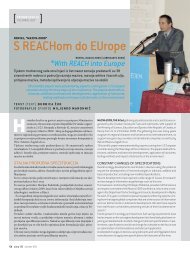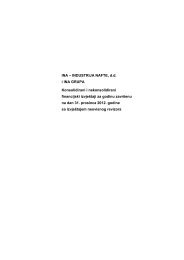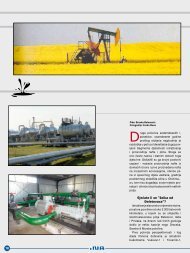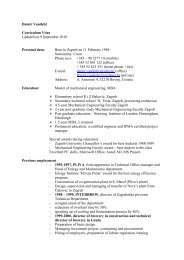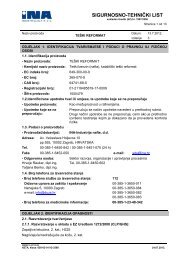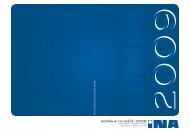2. Accounting policiesAFS financial assetsListed shares held by the Company and Group that aretraded in an active market are classified as being AFS andare stated at fair value. Fair value is determined in themanner described in Note 40. Gains and losses arisingfrom changes in fair value are recognised directly inequity in the investments revaluation reserve with theexception of impairment losses, interest calculated usingthe effective interest method and foreign exchange gainsand losses on monetary assets, which are recogniseddirectly in profit or loss. Where the investment is disposedof or is determined to be impaired, the cumulative gain orloss previously recognised in the investments revaluationreserve is included in profit or loss for the period.Dividends on AFS equity instruments are recognised inprofit or loss when the Group’s right to receive paymentsis established.The fair value of AFS monetary assets denominated in aforeign currency is determined in that foreign currencyand translated at the spot rate at the balance sheetdate. The change in fair value attributable to translationdifferences that result from a change in amortised cost ofthe asset is recognised in profit or loss, and other changesare recognised in equity.Loans and receivablesTrade receivables, loans, and other receivables that havefixed or determinable payments that are not quoted inan active market are classified as ‘loans and receivables’.Loans and receivables are measured at amortised costusing the effective interest method less any impairment.Interest income is recognised by applying the effectiveinterest rate, except for short-term receivables when therecognition of interest would be immaterial.Impairment of financial assetsFinancial assets are assessed for indicators of impairmentat each balance sheet date. Financial assets are impairedwhere there is objective evidence that, as a result of oneor more events that occurred after the initial recognitionof the financial asset, the estimated future cash flows ofthe investment have been impacted. For financial assetscarried at amortised cost, the amount of the impairmentis the difference between the asset’s carrying amountand the present value of estimated future cash flows,discounted at the original effective interest rate.The carrying amount of the financial asset is reduced bythe impairment loss directly for all financial assets with theexception of trade receivables where the carrying amountis reduced through the use of an allowance account.When a trade receivable is uncollectable, it is written offagainst the allowance account. Subsequent recoveries ofamounts previously written off are credited against theallowance account. Changes in the carrying amount ofthe allowance account are recognised in profit or loss.With the exception of AFS equity instruments, if, in asubsequent period, the amount of the impairment lossdecreases and the decrease can be related objectively toan event occurring after the impairment was recognised,the previously recognised impairment loss is reversedthrough profit or loss to the extent that the carryingamount of the investment at the date the impairment isreversed does not exceed what the amortised cost wouldhave been had the impairment not been recognised.In respect of AFS equity securities, any increase in fairvalue subsequent to an impairment loss is recogniseddirectly in equity.InvestmentsInvestments in immaterial non-consolidated companiesare generally recorded at cost less provision for anyimpairment.Financial liabilitiesFinancial liabilities are classified as other financialliabilities.Other financial liabilities, including borrowings, areinitially measured at fair value, net of transaction costs.Other financial liabilities are subsequently measured atamortised cost using the effective interest method, withinterest expense recognised on an effective yield basis.102 Financial report
The effective interest method is a method of calculatingthe amortised cost of a financial liability and of allocatinginterest expense over the relevant period. The effectiveinterest rate is the rate that exactly discounts estimatedfuture cash payments through the expected life of thefinancial liability, or, where appropriate, a shorter period.The Group derecognises financial liabilities when, and onlywhen, the Group’s obligations are discharged or cancelledor they expire.Embedded derivativesDerivatives embedded in other financial instruments orother host contracts are treated as separate derivativeswhen their risks and characteristics are not closely relatedto those of the host contracts and the host contracts arenot measured at fair value with changes in fair valuerecognised in profit or loss.In the ordinary course of business, the Company andGroup has entered into certain long-term, foreigncurrency supply and sales contracts which, under IAS 39,include embedded derivatives. An embedded derivativeis a component of a contract which has the effect thatthe cash flows arising under the contract vary, in part, ina similar way to a standalone derivative. IAS 39 requiresthat such embedded derivatives are separated from thehost contracts and accounted for as derivatives carriedat fair value, with changes in fair value being charged orcredited to the income statement, as applicable.The fair value of embedded forward foreign exchangecontracts is determined by reference to spot marketforeign currency rates at the balance sheet date, becausethere is no active forward market in the countries involvedin contracts. The fair value of an embedded inflation indexswap is determined by the reference to the cumulativeinflation index differential between the contractedinflation escalator and inflation in the country wherethe contract is executed. The long-term effects of theseembedded derivatives are discounted using a discountrate similar to the interest rate on government bonds.Segmental disclosuresFor management reporting purposes, the Group isorganized into four major operating business units. Thebusiness units are the basis upon which the Group reportsits primary segment information.Provisions for decommissioning andother obligationsProvisions are recognised when the Group has a presentobligation (legal or constructive) as a result of a past eventand it is probable (i.e. more likely than not) that an outflowof resources will be required to settle the obligation, anda reliable estimate can be made of the amount of theobligation. Provisions are reviewed at each balance sheetdate and adjusted to reflect the current best estimate.Where the effect of discounting is material, the amountof the provision is the present value of the expendituresexpected to be required to settle the obligation,determined using the estimated risk free interest rateas the discount rate. Where discounting is used, thereversal of such discounting in each year is recognised as afinancial expense and the carrying amount of the provisionincreases in each year to reflect the passage of time.Where the provision relates to the decommissioning andremoval of assets, such as an oil and gas production facility,the initial recognition of the decommissioning provision istreated as part of the cost of the related property, plantand equipment. Subsequent adjustments to the provisionarising from changes in estimates are also treated as anadjustment to the cost of property, plant and equipmentand thus dealt with prospectively in the income statementthrough future depreciation of the asset.Use of estimates in the preparation offinancial statementsThe preparation of financial statements in conformitywith International Reporting Financial Standards, aspublished by the International Accounting StandardsBoard requires management to make estimates andassumptions that affect the reported amounts ofassets, liabilities, income and expenses and disclosureof contingencies. The significant areas of estimationused in the preparation of the accompanying financialAnnual report 2007103
- Page 3:
Table of contentsIntroduction 5INA,
- Page 7 and 8:
Annual report 2007
- Page 9 and 10:
Tomislav DragiËeviÊ, President of
- Page 11 and 12:
Josip PetroviÊ, Member of the Boar
- Page 13 and 14:
Scheme of macro-organizational stru
- Page 15 and 16:
Higher output in INA’srefineriesI
- Page 17:
Poslovno izvjeπÊeAnnual report 20
- Page 20 and 21:
Vision, Mission and CoreValuesINA i
- Page 22 and 23:
Reduction of sulphur dioxide and hy
- Page 24 and 25:
Healthcare, as one of the prioritie
- Page 26 and 27:
Intellectual propertymanagementToda
- Page 29 and 30:
Business Segments
- Page 31 and 32:
Mazrur-1STConstruction of the Mazru
- Page 33 and 34:
Exploration in CroatiaPannonian bas
- Page 35 and 36:
Investments in exploration and deve
- Page 37 and 38:
Oil and gas reserves as of 31 Decem
- Page 39 and 40:
As part of safety and environmental
- Page 41 and 42:
Natural gas supplyThe production of
- Page 43 and 44:
Over the previous year, the strong
- Page 45 and 46:
At the Rijeka Oil Refinery, a contr
- Page 47 and 48:
Annual report 200747
- Page 49 and 50:
Strateπko pertnerstvoIn 2006 two n
- Page 51: All business processes of the Secto
- Page 54 and 55: Strategic partnershipwith MOLStrate
- Page 57 and 58: Financial results
- Page 59 and 60: Important financialindicators for 2
- Page 61 and 62: Refineries and MarketingSegments IF
- Page 63 and 64: Business environmentThe following f
- Page 65 and 66: (“price cap” limitation) also h
- Page 67: Annual report 200767
- Page 71 and 72: ContentsResponsibility for the Fina
- Page 73 and 74: Responsibility for thefinancial sta
- Page 75 and 76: OpinionIn our opinion, the financia
- Page 77 and 78: Notes 2007 2006Investment revenue 6
- Page 79 and 80: INA Group ConsolidatedBalance Sheet
- Page 81 and 82: INA d.d. UnconsolidatedBalance Shee
- Page 83 and 84: INA Group ConsolidatedStatement of
- Page 85 and 86: INA d.d. UnconsolidatedStatement of
- Page 87 and 88: INA Group ConsolidatedCash Flow Sta
- Page 89 and 90: Notes 2007 2006Cash flows from fina
- Page 91 and 92: In its session of 22 July 2005, the
- Page 93 and 94: Management Board from 5th May 2006d
- Page 95 and 96: IFRIC 11 IFRS 2: Group and Treasury
- Page 97 and 98: GoodwillGoodwill arising on the acq
- Page 99 and 100: Where an impairment loss subsequent
- Page 101: Deferred taxDeferred tax is recogni
- Page 105 and 106: Furthermore, the time determined fo
- Page 107 and 108: 3. Sales revenueRevenue represents
- Page 109 and 110: 7. Finance costsINA GroupINA d.d.20
- Page 111 and 112: 9. Earnings per shareINA Group2007
- Page 113 and 114: ) By asset typeINA GroupOil and gas
- Page 115 and 116: ) By asset typeINA d.d.Oil and gasp
- Page 117 and 118: I) Oil and gas reservesThe ability
- Page 119 and 120: 13. Investments in subsidiariesBasi
- Page 121 and 122: 14. Investments in associates and j
- Page 123 and 124: 17. Available-for-sale assetsCompan
- Page 125 and 126: 19. Receivables from buyers, netINA
- Page 127 and 128: 22. Paid expenses of the future per
- Page 129 and 130: 25. Liabilities to suppliers, taxes
- Page 131 and 132: Averageweightedinterest rateAverage
- Page 133 and 134: was contracted with a 5-year expiry
- Page 135 and 136: INA GroupINA d.d.2007 2006 2007 200
- Page 137 and 138: o podjeli proizvodnje - UPP) on the
- Page 139 and 140: The change of the present value of
- Page 141 and 142: 34. Retained earningsINA GroupRetai
- Page 143 and 144: By business segmentsINA d.d.Researc
- Page 145 and 146: By business segmentsINA GroupResear
- Page 147 and 148: By business segmentsINA d.d.Researc
- Page 149 and 150: By geographical areasINA d.d.Republ
- Page 151 and 152: Income from sale of goodsand servic
- Page 153 and 154:
Income from the sale of products to
- Page 155 and 156:
ond, exploratory and confirmatory w
- Page 157 and 158:
39. Unforeseen obligationsInvestmen
- Page 159 and 160:
Goals of financial risk managementT
- Page 161 and 162:
was valid throughout the year. An i
- Page 163 and 164:
INA d.d. interest-free liabilities
- Page 165 and 166:
42. Approval of the financial state
- Page 167 and 168:
CROBENZ d.d. ZagrebRadniËka cesta



